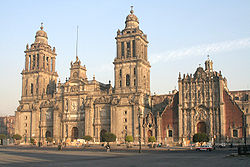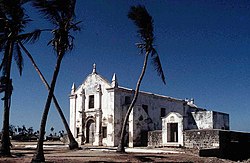Colonial architecture

Colonial architecture is a hybrid architectural style that arose as colonists combined architectural styles from their country of origin with design characteristics of the settled country. Colonists frequently built houses and buildings in a style that was familiar to them but with local characteristics more suited to their new climate.[1] Below are links to specific articles about colonial architecture, specifically the modern colonies:
Spanish colonial architecture
- North America
- Viceroyalty of New Spain
- Caribbean
- Spanish West Indies

Spanish colonial cities were usually laid out according to La Traza, a strict quadratic plan where the town radiated out from a central plaza (here the Plaza de Armas in Cusco)
- South America
- Viceroyalty of Peru, Viceroyalty of New Granada, and Viceroyalty of the Río de la Plata
- Spanish Colonial architecture in Argentina
- Spanish Colonial architecture in Chile
- Spanish Colonial architecture in Colombia
- Spanish Colonial architecture in Peru
- Spanish Colonial architecture in Venezuela
Paoay Church Ilocos Sur Philippines is a fine example of Spanish Earthquake Baroque only found in the Philippines
- Spanish missions in South America
- Asia
Portuguese colonial architecture

b. 1498, Mozambique
- Asia
- South America
British colonial architecture


British colonial architecture are most visible in North America, the British West Indies, South Asia, Australia, New Zealand and South Africa.
- North America
- South Asia
- Australia
- Asia-Pacific
French colonial architecture
- Indochina
- North America
- South Asia
- French colonial architecture in India
Dutch colonial architecture

- Indonesia
- Dutch colonial architecture of Indonesia
- Old Indies Style
- Indies Empire style
- New Indies Style
- Dutch colonial architecture of Indonesia
- North America
- South Asia
- Dutch colonial architecture in India
- Colonial architecture in Sri Lanka
- South Africa
Russian colonial architecture

Russian colonial architecture is primarily represented in Siberia, Far East and Central Asia. The best example of Russian colonial architecture in Siberia is the architecture of Irkutsk, Tobolsk, Tomsk, Krasnoyarsk, Omsk and Yeniseysk. Russian colonial architecture in Siberia was primarily built out of wood due to the abundance of it in the region and is noticeable for its wooden carving.[2]
- Siberia
- Siberian baroque
- Lace houses
- Central Asia
- Turkey
Italian colonial architecture

Eritrea was Italy's first African colony. Its first capital, Massawa, contains a large amount of early Italian colonial architecture, characterized by historicism and inspiration from Venetian Gothic and Italian Neoclassical architecture. The colonial architecture and orthogonal street grid of Asmara, the colony's second capital, was inscribed as a UNESCO World Heritage Site in 2017. Much of the city's colonial architecture dates to the fascist era, during which Benito Mussolini encouraged architects and planners to transform the city into a "Little Rome".[3][4]
Somalia also contains a wide range of Italian colonial architecture, dating back to its colonial era. In Mogadishu, the residence of most of the colony's eventual 50,000 Italian residents, colonial architects undertook large planning projects and erected monuments such as the still-extant triumphal arch dedicated to Umberto I, the largely destroyed Cathedral of Mogadiscio, and various government buildings. The Italian-built Villa Somalia remains Somalia's presidential residence. Unlike colonial schemes in Libya and Eritrea, Italian colonial authorities built within existing cities in Somalia, not building new villages or towns for settlers.[5]

Before the consolidation of Italian Cyrenaica and Italian Tripolitania, Libya's colonial masters undertook significant building projects in Italian styles, such as the construction of Tripoli's Cathedral, built in a Venetian Gothic style. Following the founding of Italian Libya, Italian Fascist architecture became the standard for the massive infrastructural and settlement-related projects that Mussolini's Italy undertook. In cities such as Tripoli and Benghazi, colonial architects and urban planners undertook large-scale urban projects, such as the construction of Benghazi's monumental Lungomare (sea-walk), new urban districts for Italian settlers, and Catholic religious buildings, including Benghazi's and Tripoli's cathedrals. The fascist government's constructions were usually characterized by use of the Italian Rationalist and Neoclassical styles. Starting in 1938, the colony's Public Works Department sponsored the building of 27 new villages meant for Italian settlement, mostly in Cyrenaica, which epitomized a Rationalism informed by local Arab architectural mores. Giovanni Pellegrini, one of the most prominent designers of these agrarian villages, attempted to synthesize Arab and Italian architecture to settlements best fitted to Cyrenaica's arid climate.[6][7]
Italy's occupation of the Dodecanese bore a significant amount of modernist and art deco buildings throughout the archipelago. Colonial architects also constructed several new towns and villages, such as Portolago, now known as Lakki. Contrasting with much of the built remnants of Italian colonialism in Africa, Italian architecture in the Dodecanese often remains in good repair.[8]
Italy's brief
See also
References
- ISBN 9781580930512. Retrieved January 26, 2014.
world colonial architecture.
- ^ "A City Made of Lace: Wooden Architecture of Irkutsk". 1baikal.ru. Retrieved 2025-01-26.
- ^ "Asmara: A Modernist African City". whc.unesco.org. Retrieved 2024-08-17.
- ISSN 0261-3077. Retrieved 2024-08-17.
- ISSN 1369-801X.
- ISBN 9788846756657.
- ^ "Italian Ghosts, Lybia (2014)". DAAR. Retrieved 2024-08-17.
- ^ Rhodian (2019-02-02). "The Italian Architecture in the Dodecanese". Discover Rhodes. Retrieved 2024-08-17.
- ISSN 1369-801X.
External links
Colonial architecture.
- Website on colonial architecture with 29,000 pictures of colonial buildings around the world by Social Sciences and Humanities Research Council of Canada and the National Endowment for the Humanities



